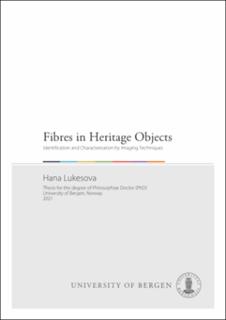| dc.contributor.author | Lukesova, Hana | |
| dc.date.accessioned | 2021-08-19T08:40:31Z | |
| dc.date.available | 2021-08-19T08:40:31Z | |
| dc.date.issued | 2021-08-27 | |
| dc.date.submitted | 2021-08-17T02:01:38Z | |
| dc.identifier | container/db/dc/9b/51/dbdc9b51-5d9c-4d8f-b988-654bfb181745 | |
| dc.identifier.isbn | 9788230843468 | |
| dc.identifier.isbn | 9788230840504 | |
| dc.identifier.uri | https://hdl.handle.net/11250/2770227 | |
| dc.description.abstract | The work presented in this thesis focuses on the identification and characterisation of plant fibres from cultural heritage objects. The main emphasis is on method development (Archaeometry) in the field of optical microscopy. This has been done in three ways: i) Investigating the validity of established plant fibre identification techniques applied to historical and archaeological samples; ii) The development of an identification method for a hitherto little-regarded textile plant fibre species and iii) Application of the identification methods on cultural heritage objects.
The thesis consists of five articles that are divided into the three categories listed above. The first category covers the overall methodology of how to adapt methods, that were developed for investigation on modern fibres, on archaeological materials. This is discussed in one separate article concerning questions regarding sampling, correct performing of tests as well as result evaluation of degraded sample materials that are in many ways different from the modern ones. The second article focuses on two features that have been used for the identification of fibres: the cross-section shape and the lumen shape. The application of these two features, in the investigation of cultural heritage materials, was re-evaluated. It was concluded that they cannot be used on their own as distinguishing features for plant fibres.
The material resources of ancient societies differ from the modern ones. Not only the species used for commercial fibres in modern times were used for textile production in past. The identification diagrams, derived mainly from industry and forensic science, are depending on relevant species. If species that were used in past are not included, the diagrams cannot be correct. The research area for future studies is therefore huge. The second category aims to diminish this discrepancy and focus on the development of an identification method for the (in a textile context) little-regarded species hops Humulus lupulus. This work is presented in a method article, where a new identification diagram, including hops, can be found. According to various written sources, hop fibres were used for textiles in Scandinavia. This was confirmed in an experimental study which is a part of the third category, concerning the application of identification methods on cultural heritage objects. Here, in one article, the recently developed identification diagram for plant fibres, which includes the hops species was applied on historical textile samples, with results confirming that hops were used for textiles in past. The second article was about the modified Herzog test applied on degraded Viking Age and Merovingian Period objects from the Late Iron Age Collection of the University Museum of Bergen. The results showed that flax (Linum usitatissimum) was used for undergarments as well as small textile accessories at this time in western Norway. | en_US |
| dc.language.iso | eng | en_US |
| dc.publisher | The University of Bergen | en_US |
| dc.relation.haspart | Paper 1: Lukesova, H.& Holst, B. (2021): “Is Cross‐Section Shape a Distinct Feature in Plant Fibre Identification?” Archaeometry, 63(1), 216-226. The article is available at: <a href="https://hdl.handle.net/11250/2730152" target="blank">https://hdl.handle.net/11250/2730152</a> | en_US |
| dc.relation.haspart | Paper 2: Skoglund, G., Holst, B., & Lukesova, H. (2020). “First experimental evidence of hop fibres in historical textiles.” Archaeological and Anthropological Sciences, 12(9). The article is available at: <a href="https://hdl.handle.net/11250/2730608" target="blank">https://hdl.handle.net/11250/2730608</a> | en_US |
| dc.relation.haspart | Paper 3: Lukesova, H., Andersen, H. L., Kolínová, M., & Holst, B. (2019). “Is It Hop? Identifying Hop Fibres in a European Historical Context.” Archaeometry, 61(2), 494–505. The article is available in the thesis file. The article is also available at: <a href=" https://doi.org/10.1111/arcm.12437" target="blank">https://doi.org/10.1111/arcm.12437</a> | en_US |
| dc.relation.haspart | Paper 4: Lukesova, H., Palau, A.S., Holst B. (2017) “Identifying Plant Fibre Textiles from Norwegian Merovingian Period and Viking Age Graves: The Late Iron Age Collection of the University Museum of Bergen.” Journal of Archaeological Science: Reports, 13, 281-285. The article is available in the thesis file. The article is also available at: <a href=" https://doi.org/10.1016/j.jasrep.2017.03.051" target="blank">https://doi.org/10.1016/j.jasrep.2017.03.051</a> | en_US |
| dc.relation.haspart | Paper 5: Lukesova, H. (2017): “Application of Herzog test on Archaeological Plant Fibre Textiles. Possibilities and limits of polarized light microscopy”, In Bravermanová, M. – Březinová, H. – Malcolm-Davies, J. (Eds.) Archaeological Textiles – Links Between Past and Present. NESAT XIII. Liberec – Praha. The article is not available in BORA. | en_US |
| dc.rights | In copyright | |
| dc.rights.uri | http://rightsstatements.org/page/InC/1.0/ | |
| dc.title | Fibres in Heritage Objects : Identification and Characterisation by Imaging Techniques | en_US |
| dc.type | Doctoral thesis | en_US |
| dc.date.updated | 2021-08-17T02:01:38Z | |
| dc.rights.holder | Copyright the Author. All rights reserved | en_US |
| dc.contributor.orcid | https://orcid.org/0000-0003-0944-2932 | |
| dc.description.degree | Doktorgradsavhandling | |
| fs.unitcode | 12-24-0 | |
